I recently reorganized my pantry, and it’s honestly changed how I approach cooking and meal planning. When you can actually see what you have and everything has a designated spot, grocery shopping becomes easier, food waste goes down, and you stop buying duplicates of things you already own.
Whether you have a full walk-in pantry or just a few cabinets, good organization makes such a difference. Here are the storage ideas that have worked best for me.

Start With a Clean Slate
Before you add any organization systems, take everything out of your pantry. Check expiration dates, toss anything that’s past its prime, and group similar items together.
This is also the perfect time to wipe down shelves and really see what space you’re working with. You might be surprised at how much you’ve been holding onto that you don’t actually need.

Clear Storage Containers
This was the game-changer for me. Transferring dry goods into clear containers makes everything so much more visible and accessible.
What to store in containers:
- Flour, sugar, and baking essentials
- Rice, pasta, and grains
- Cereal and granola
- Nuts and dried fruit
- Snacks like crackers and pretzels
- Baking chips and sprinkles
Choose containers that stack well and fit your shelves. Square or rectangular containers use space more efficiently than round ones. Make sure they’re airtight to keep food fresh longer.
Label everything clearly. Even if you can see what’s inside, labels help other people in your household and ensure things get put back in the right place.
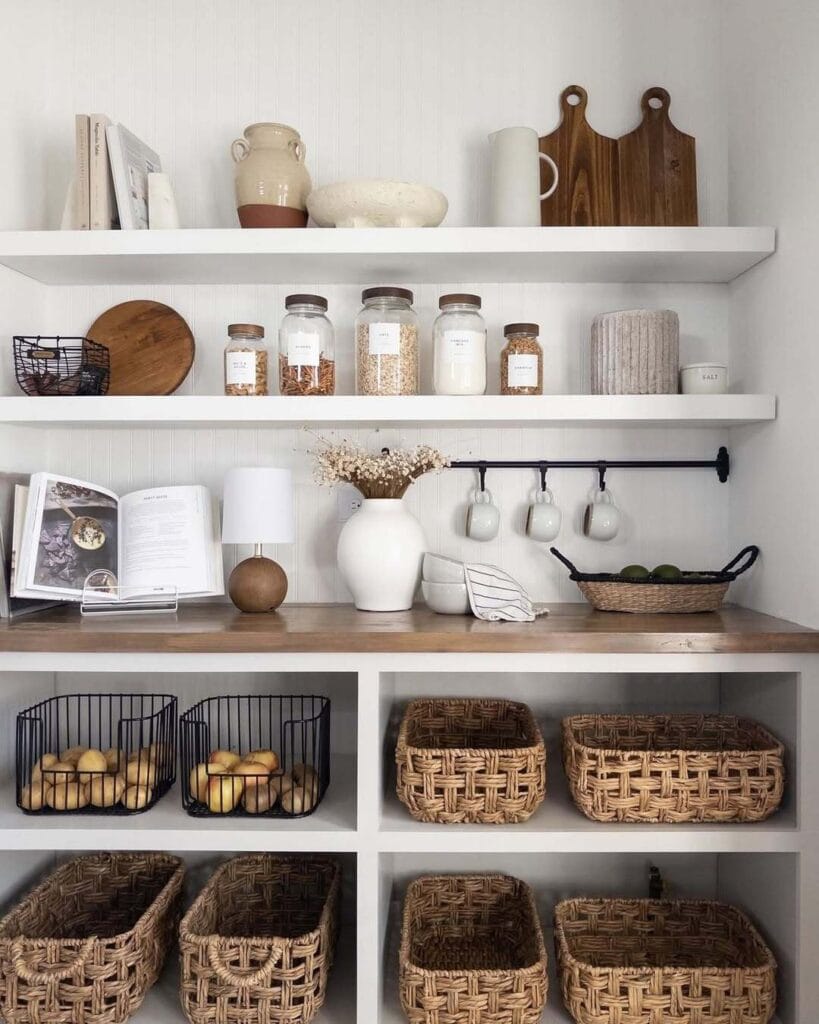
Lazy Susans for Corner Spaces
Lazy Susans are perfect for deep shelves or corner cabinets where things tend to get lost. Use them for oils and vinegars, spices, condiments, or small jars.
Being able to spin the turntable means you can access items in the back without moving everything in front. This is especially helpful for pantries with deep shelves where things naturally migrate to unreachable spots.
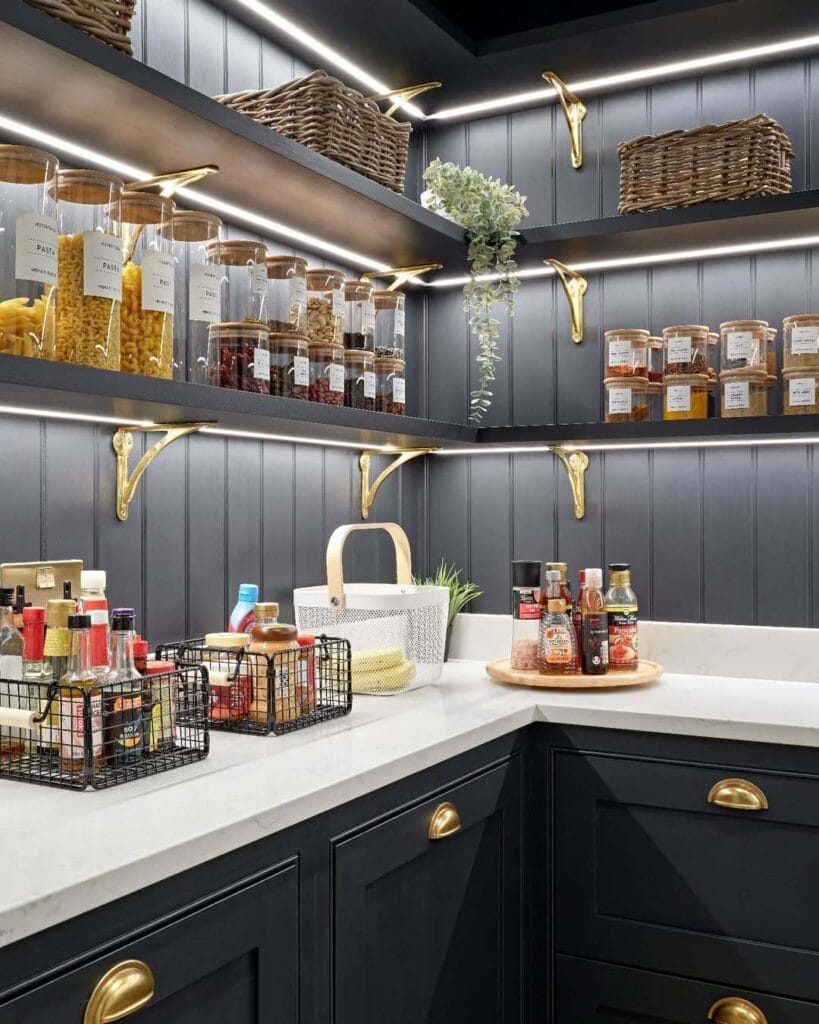
Tiered Shelf Risers
These create extra levels on your existing shelves so you can see everything at once. They’re perfect for canned goods, jars, or bottles.
Instead of stacking cans on top of each other where you can only see the front row, risers let you see every can at a glance. This prevents you from forgetting about items and helps you use what you have.
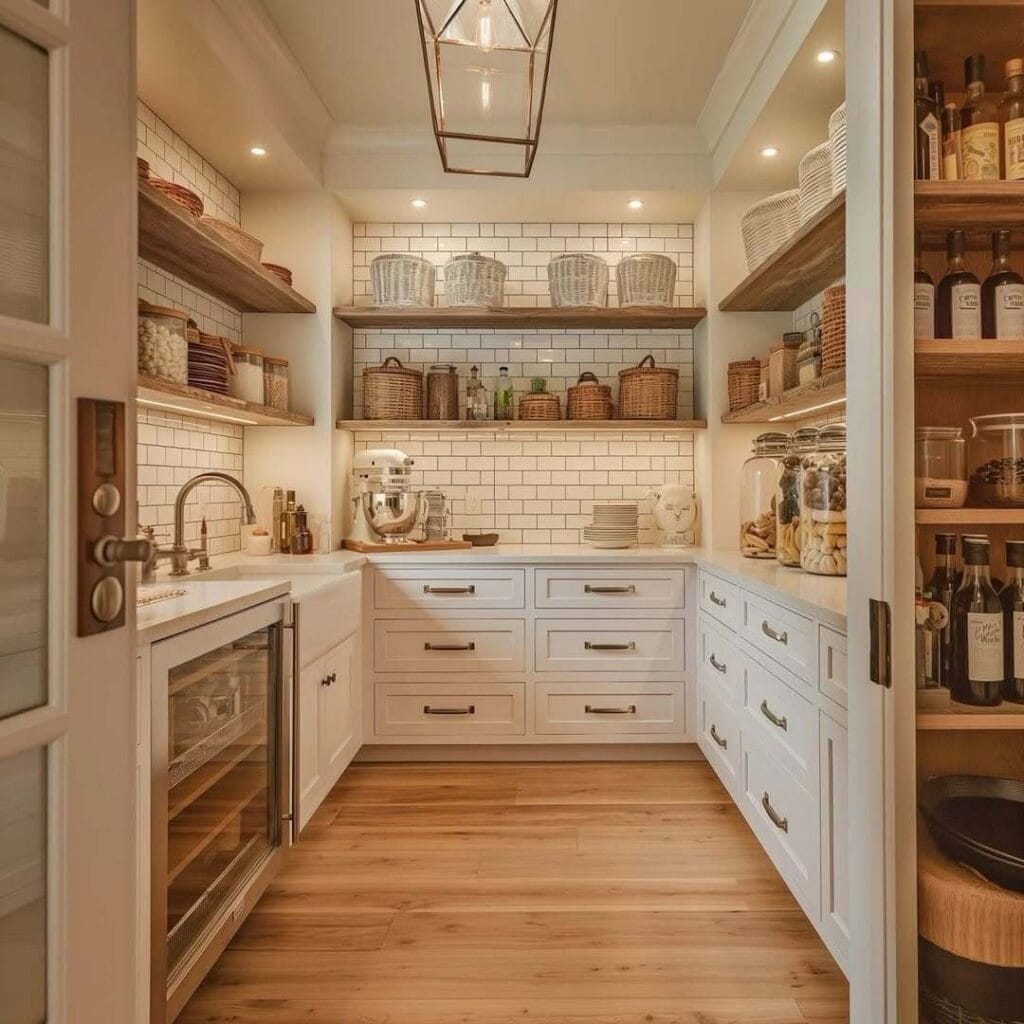
Bins and Baskets
Group similar items together in bins or baskets. This keeps small items contained and makes it easy to pull out a whole category at once.
Ideas for bin categories:
- Baking supplies (baking powder, vanilla, chocolate chips)
- Breakfast items (oatmeal packets, pancake mix)
- Snacks (individual chip bags, granola bars)
- Asian cooking ingredients (soy sauce, rice vinegar, sesame oil)
- Pasta and pasta sauces
- Instant meals (soup cups, ramen, mac and cheese)
Label the front of each bin so everyone knows what goes where. Wire baskets work well because you can see through them, while solid bins are good for concealing less attractive packaging.
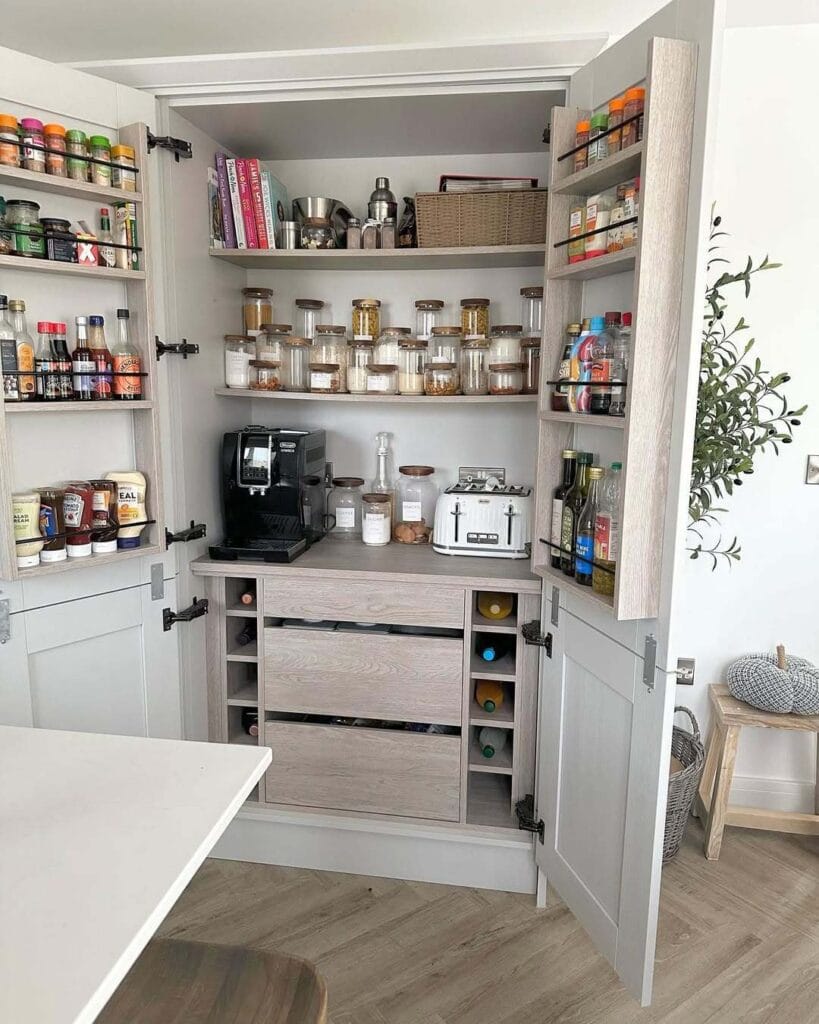
Door Storage
Don’t forget about the back of your pantry door if you have one. Over-the-door organizers are perfect for items that don’t need much depth.
Use door storage for spice packets, small sauce bottles, snack bars, tea bags, or aluminum foil and plastic wrap. Just make sure whatever system you use doesn’t interfere with the door closing properly.
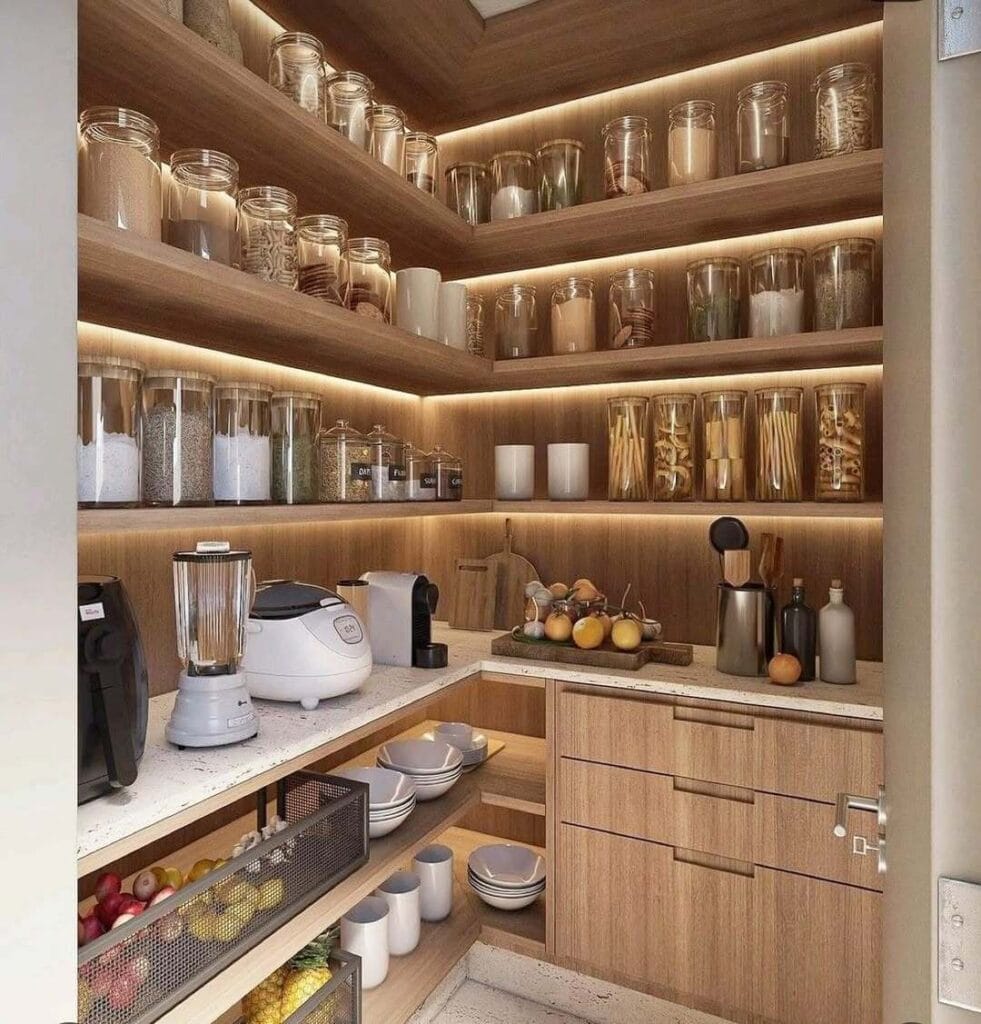
Vertical Dividers for Baking Sheets
If you store baking sheets, cutting boards, or cooling racks in your pantry, vertical dividers are a lifesaver. They let you slide items in and out individually instead of unstacking everything to reach the one you need.
You can buy adjustable shelf dividers or use tension rods placed vertically to create slots.
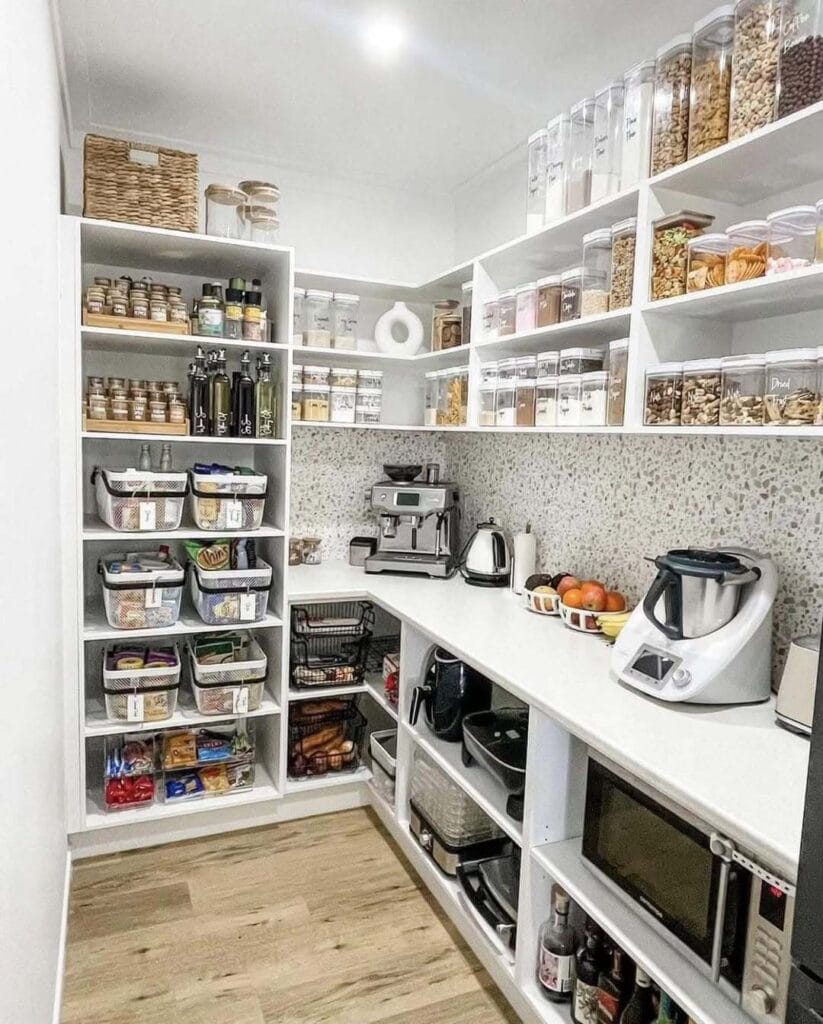
Pull-Out Drawers or Shelves
If you have the budget and a permanent pantry space, pull-out drawers or shelves are worth considering. They bring items from the back forward so you can see and access everything easily.
These work especially well for lower shelves where you’d otherwise have to crouch down and reach back to find things.
Uniform Your Packaging
If possible, remove items from their original bulky packaging and consolidate them.
Transfer snacks from big boxes into smaller containers. Combine pasta from multiple partial boxes into one container. Move tea bags to a smaller container instead of keeping them in the original box.
This saves so much space and creates a more cohesive, organized look.

Create Zones
Organize your pantry by creating zones for different types of food. This makes it intuitive to find what you need and put things away.
Sample zones:
- Breakfast zone (cereal, oats, coffee, tea)
- Baking zone (flour, sugar, baking powder, chocolate chips)
- Snack zone (chips, crackers, nuts)
- Canned goods zone
- Pasta and grains zone
- Condiments and sauces zone
Keep items you use most frequently at eye level and within easy reach. Store occasional-use items on higher or lower shelves.

Inventory System
Keep a running inventory of what you have, especially for items you buy in bulk or things with expiration dates. This can be as simple as a magnetic notepad on your fridge where you write down when you’re running low on something.
Some people like to keep a list inside the pantry door of everything they have so they can check before grocery shopping. Find what works for your style.
First In, First Out
When you restock your pantry, practice FIFO—first in, first out. Place newer items behind older ones so you use the oldest products first. This reduces waste and ensures nothing expires before you use it.
This is especially important for canned goods, packaged foods, and anything with a shorter shelf life.
Snack Station
If you have kids or just love easy-to-grab snacks, create a designated snack area at a height everyone can reach. Use clear containers or bins filled with individual snacks.
This prevents constant questions about what’s available and helps everyone make their own selections. It also makes it easy to see when snacks are running low.

Bulk Storage Solutions
If you buy items in bulk, you need a system to store them without overwhelming your space.
Large airtight containers work well for flour, rice, and other bulk staples. Some people use large plastic bins with tight-fitting lids. Make sure to label everything clearly with the contents and the date you filled it.
Store bulk extras in a separate area if possible, keeping just a working amount in your main pantry.
Small Pantry Solutions
If you’re working with limited cabinet space instead of a full pantry:
Maximize vertical space: Use stackable containers and risers to create more layers.
Use cabinet doors: Add small racks or hooks inside cabinet doors.
Think beyond the kitchen: If you have extra storage elsewhere, keep backup supplies there and just keep active items in the kitchen.
Declutter regularly: With limited space, you need to be more selective about what you keep.
Keep It Maintained
Set aside time monthly to tidy up your pantry. Wipe up spills, check for expired items, and reorganize anything that’s gotten out of order.
A quick weekly check helps too—just a few minutes to put things back where they belong and see what needs to be replenished.
Make It Work for Your Life
The best pantry organization system is one that actually works for how you cook and eat. If you bake a lot, prioritize baking supplies. If you’re all about quick meals, focus on organizing your convenience foods and meal components.
Don’t feel like you need to buy matching containers for everything or create an Instagram-perfect pantry. Focus on function first. If it helps you cook better meals, waste less food, and stress less about meal planning, then your system is working.